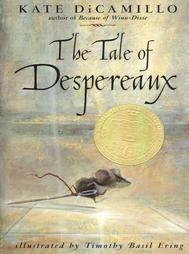
2004 Newbery Medal Winner
By Kate DiCamillo
Narrated by Graeme Malcolm
2003
Candlewick Press
ISBN 0763617229
Ages 9-12
It is the story of an extremely small mouse with big ears-- Despereaux, the only survivor in his mother's last litter of mice. He defied the odds by surviving, in spite of the fact that everyone thought he wouldn't, and he was even born with his eyes open, which was unheard of for mice. On top of that, he found out he could interpret symbols on a page and understand the words, although not necessarily the meaning. He hadn't lived long enough for that. And the first time he heard music, his little mind compared it to honey to his ears, and he was drawn to it-- right to the foot of the king playing and singing for his daughter. Despereaux's life as a mouse was never the same after that.
The book is divided into multiple books, each beginning as single paths, but they eventually intertwine and come to a very satisfying conclusion. The first book introduces Despereaux; the second book introduces a rat named Chiaroscuro, or Roscuro for short, although it wasn't that much shorter; and the third book tells us about a pitiful servant girl named Miggory Sow. Other interesting characters weave their way in and out of the stories: the Princess Pea, Botticello (a very persuasive rat), Despereaux's family and the other mice who condemned Despereaux, the King, the Cook, Gregory the dungeon keeper, and others. I will not spoil the story by sharing more, but it is unlike any I've ever read.
Graeme Malcolm's amazing narration grabbed me from the beginning and wouldn't let go until I finished listening to it. In the book version, the narrator addresses each of us as Reader, but in the audio-book, he refers to each of us as Listener, and pulls us into the tale as if we have a duty to get emotionally involved. And it worked. Malcolm has quite an array of accents he uses extremely well-- even back and forth in quick-fire conversation. His normal narrator's voice is British, which he also uses for the royalty in the story. For Despereaux and his family, a French accent is used. For the servants, Malcolm uses a lower-class British cockney. My favorite accent, though, was the rats' speaking voices-- a very slick Italian.
Since I used the audio version, the only illustration I saw was the cover, as seen above. After I heard the part in the story about the demise of Despereaux's tail, I was convinced the cover was wrong because I saw a tail. On second look, though, I see that it was not a tail, but rather the red thread. The illustration was right on.
Kate DiCamillo took some ordinary items-- things we wouldn't give a second thought about: red thread, soup, pages of a book, a needle, a spoon, and she spun a wonderful story around them. She also had me thinking differently about light and darkness, how special the gifts of reading and music are, and the importance of doing what's right against impossible odds. And also important-- that my own version of happily ever after has a great deal to do with my own attitude, effort and actions rather than fate or wishful thinking.
This is definitely not just another mouse story. Kate DiCamillo, I honor you.